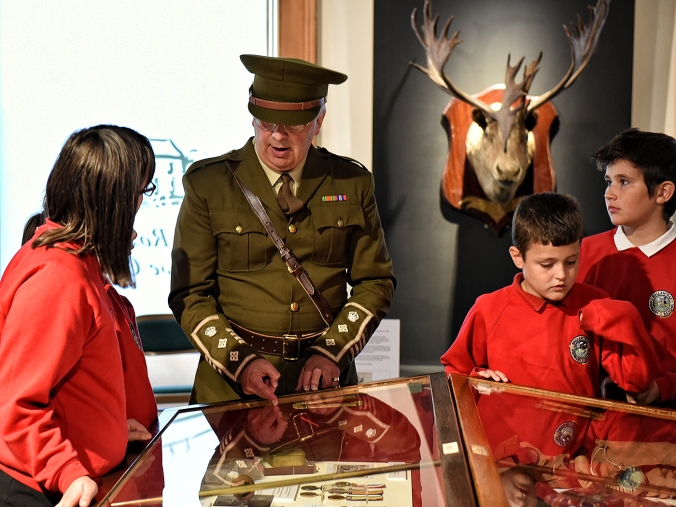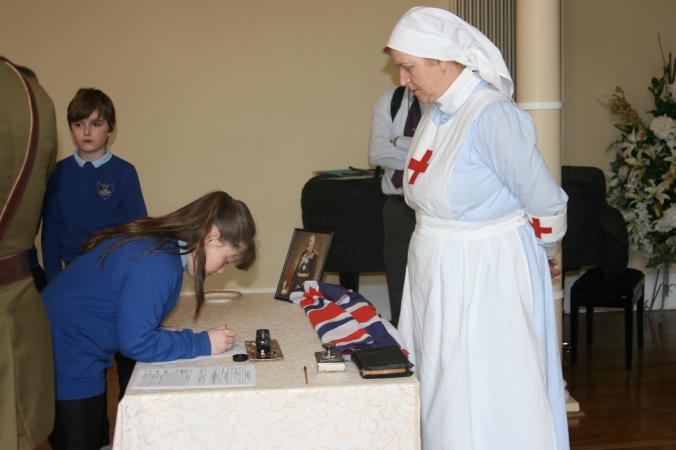Artemis Scotland have delivered a series of interactive workshops at three Next of Kin tour venues exploring identity in the First World War. In this guest post, Managing Director Jackie Lee gives an insight into the immersive format of the sessions and the impact on school pupil participants.
Artemis Scotland Ltd is a visitor experience consultancy which specialises in formal and informal learning using costumed characters.
For Next of Kin we developed a site specific workshop based on local research for three venues, Dumfries Museum, Rozelle House in Ayr and Low Parks Museum in Hamilton. Each venue provided a different environment in terms of available spaces, but all had in common the use of the Next of Kin exhibition with additional material reflecting their own collections and stories relating to the First World War.
We took as the common thread linking venues, objects, stories and how the war has been remembered over the last century as question of identity. In advance teachers were told that the experience would be immersive and the atmosphere one of strict discipline.
We looked at patterns of recruitment in each location and how the process gradually took away the individual identity of young men as they were formed, by the process of recruitment and training, into battalions for Kitchener’s New Army. Using ‘a retired Boer War Officer’ Colonel McCall, (who was based on a real person), emphasising the shortage of training officers, pupils were put first under a range of pressures and methods of propaganda to demonstrate why young men were so willing at least in the early stages of the war to join up. They were then taken through basic drill taught to the interpreter by a retired Sergeant Major, who had himself once guarded Rudolph Hess. The visible transformation in the appearance of the pupils as they changed from individuals into a battalion was quite remarkable leading many teachers to comment on how they wished drill was part of the contemporary school day as it once was!
A different approach was taken with regard to the impact of identity on women, particularly middle and upper middle class women. Pupils were taken under the wing of ‘matron’ who was recruiting Volunteer Aid Detachment (VAD) Nurses from the drawing rooms of the elite families of British Society. Pupils learnt that these girls, many of whom had never done a day’s work in their lives, were for the first time given an individual identity. Many flourished under a regime which was harsh and tasks which were tedious such as bandage rolling and washing patients. Pupils were given an opportunity to handle objects and consider materials such as enamel ware and sphagnum moss as a field dressing.
Boys and girls were given both experiences together. A number of pupils were selected at random by the interpreters to assist the Colonel or Matron in their tasks. In some cases teachers expressed surprise at the abilities of pupils who were unexpectedly highly engaged in the activity, for example as a young man identified as possible officer material who would have to take the drill forward once back in the classroom.
Pupils were brought back into the 21st century and guided into the exhibition. They were told how as the casualty numbers rose families faced the problem of how to hang on to the memory of their loved ones and government how best to remember the sacrifice and restore the identities of those who had been so submerged by the military experience. This of course in both cases was done through objects. Pupils were encouraged to find one or two objects and/or stories which interested or “spoke to them”. Interpreters were available to interact and prompt exploration.
Workshops ended with a discussion about the objects, which represented a personal memory for families and those which represented the state’s difficult task of remembrance and commemoration.

Jackie Lee of Artemis Scotland as the VAD Nurse, Mrs Monteith, and Dr Chris Lee of Artemis Scotland as Colonel McCall
As the Next of Kin exhibition continues to tour, learning activities exploring individual experiences of the conflict will take place at partner museums. See the Next of Kin website to find out about the events programme at the current venue, Grampian Transport Museum.
You can also download the associated Next of Kin learning resource pack here, providing information about key objects and ideas for creative craft and role-play activities for use in your own First World War workshops.





